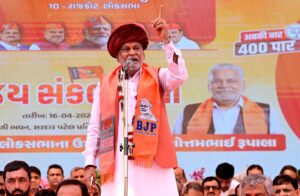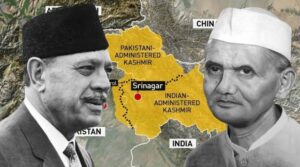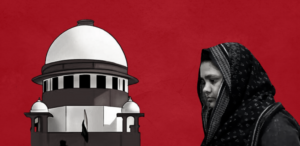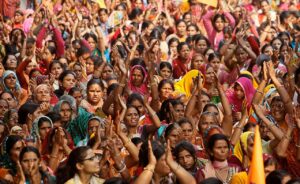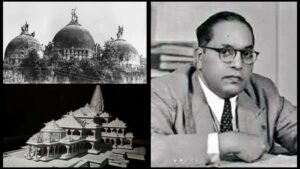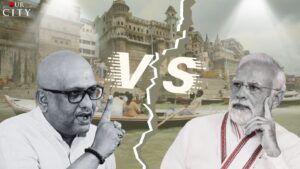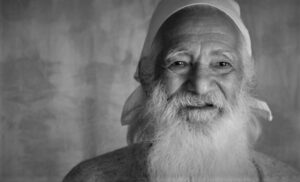A day before this day in 1971, Bangladesh Liberation War had begun. It took 12 days to make Pakistan army surrender to Indian forces unconditionally with general Amir Abdullah Khan Niazi and 94,000 troops.
Chronology
Field Marshal Sam Manekshaw of India made it clear to the Pakistani general on December 13 that “You surrender or we wipe you out” as India’s ground and air assault on the western and eastern front caused the Pakistan Army to collapse.
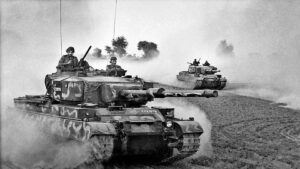 The governor of East Pakistan was holding a meeting when the Indian Air Force (IAF) struck the home on December 14. Bogra, Pubail, Rupganj, and the Sylhet Railway Station were taken over by the Indian Army. As the Indian army defeated Pakistan, Brigadier Usman, commander of the 50 PARA Brigade began operations to drive the enemy out of Kot and took Chingas on the route to Rajouri.
The governor of East Pakistan was holding a meeting when the Indian Air Force (IAF) struck the home on December 14. Bogra, Pubail, Rupganj, and the Sylhet Railway Station were taken over by the Indian Army. As the Indian army defeated Pakistan, Brigadier Usman, commander of the 50 PARA Brigade began operations to drive the enemy out of Kot and took Chingas on the route to Rajouri.
The Sam ‘Bahadur’
Manekshaw became the first Indian Army commander to be raised to the rank of field marshal while serving as the Army chief during the 1971 operation.
 India’s field marshal, a veteran of the British forces’ World War II battle in Burma, was active in the affairs of Kashmir during the tense months of 1947 when the Maharaja signed the Instrument of Accession.
India’s field marshal, a veteran of the British forces’ World War II battle in Burma, was active in the affairs of Kashmir during the tense months of 1947 when the Maharaja signed the Instrument of Accession.
On June 8, 1969, he was named the eighth chief of staff of the Army. Known as “Sam Bahadur” in the Army, particularly among his soldiers, he was credited with seizing complete strategic command of the Bangladesh operation, led by Prime Minister Indira Gandhi.
Recognising Bangla’desh’
The Indian Army took Hardinge Bridge, Khetlal and Madhupur, on December 12, 1971. In order to seize Dhaka. Narsingdi was constructed as a base. When the Pakistani army carried out a widespread genocide against the Bengali community of what was then East Pakistan, the Indo-Pak conflict of 1971 broke out.
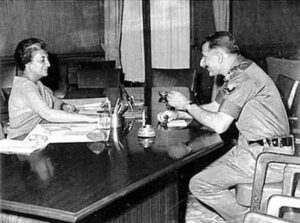 Following an invasion by India’s neighbor, Prime Minister Indira Gandhi declared that her government fully supported the independence movement of the people of East Pakistan and made the decision to declare war on that country.
Following an invasion by India’s neighbor, Prime Minister Indira Gandhi declared that her government fully supported the independence movement of the people of East Pakistan and made the decision to declare war on that country.
The Indian Air Force persisted in its home strike on Pakistan even as India’s hold over East Pakistan grew more firm. The mission eventually evolved into a series of fighter close-support, anti-radar, and daylight airfield attacks. Following Dhaka’s collapse on December 15, hostilities were declared to have finished on December 17. As Bangladesh was established, India asserted significant territorial gains in West Pakistan and the independence of Pakistan’s eastern region.
Consequences
In terms of casualties on the ground, India suffered 12,000 wounds and lost 3,000, while Pakistan suffered 8,000 killed and 25,000 injured. There was also an uneven loss of armored vehicles. It was Pakistan’s biggest loss.
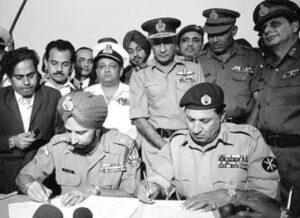 Lt Gen Niazi of Pakistan and Lt Gen Aurora of India signed the “Instrument of Surrender” for Pakistani soldiers stationed in East Pakistan on December 16, 1971, at the Ramna Race Course in what is now Dhaka. Pakistan suffered a psychological blow as a result of losing to fierce rival India; it was an utter and humiliating defeat.
Lt Gen Niazi of Pakistan and Lt Gen Aurora of India signed the “Instrument of Surrender” for Pakistani soldiers stationed in East Pakistan on December 16, 1971, at the Ramna Race Course in what is now Dhaka. Pakistan suffered a psychological blow as a result of losing to fierce rival India; it was an utter and humiliating defeat.
After gaining independence, Bangladesh emerged as the fourth most populous Muslim state globally. On January 10, 1972, Mujibur Rahman, who had been imprisoned in West Pakistan, was freed, and he returned to Dhaka to assume the office of President of Bangladesh.
The hero of the Bangladesh war was buried in Ootacamund (Ooty) after passing away on June 27, 2008, at the age of 94, in a military hospital in Wellington, Tamil Nadu.
Sam was a “soldier’s general” and without a doubt the best soldier in India.









